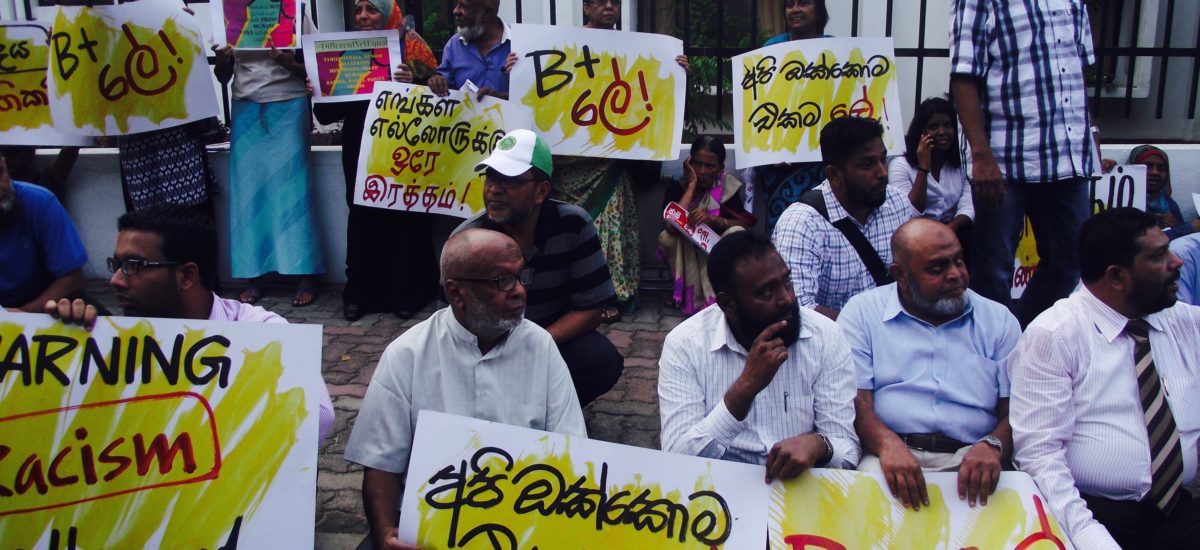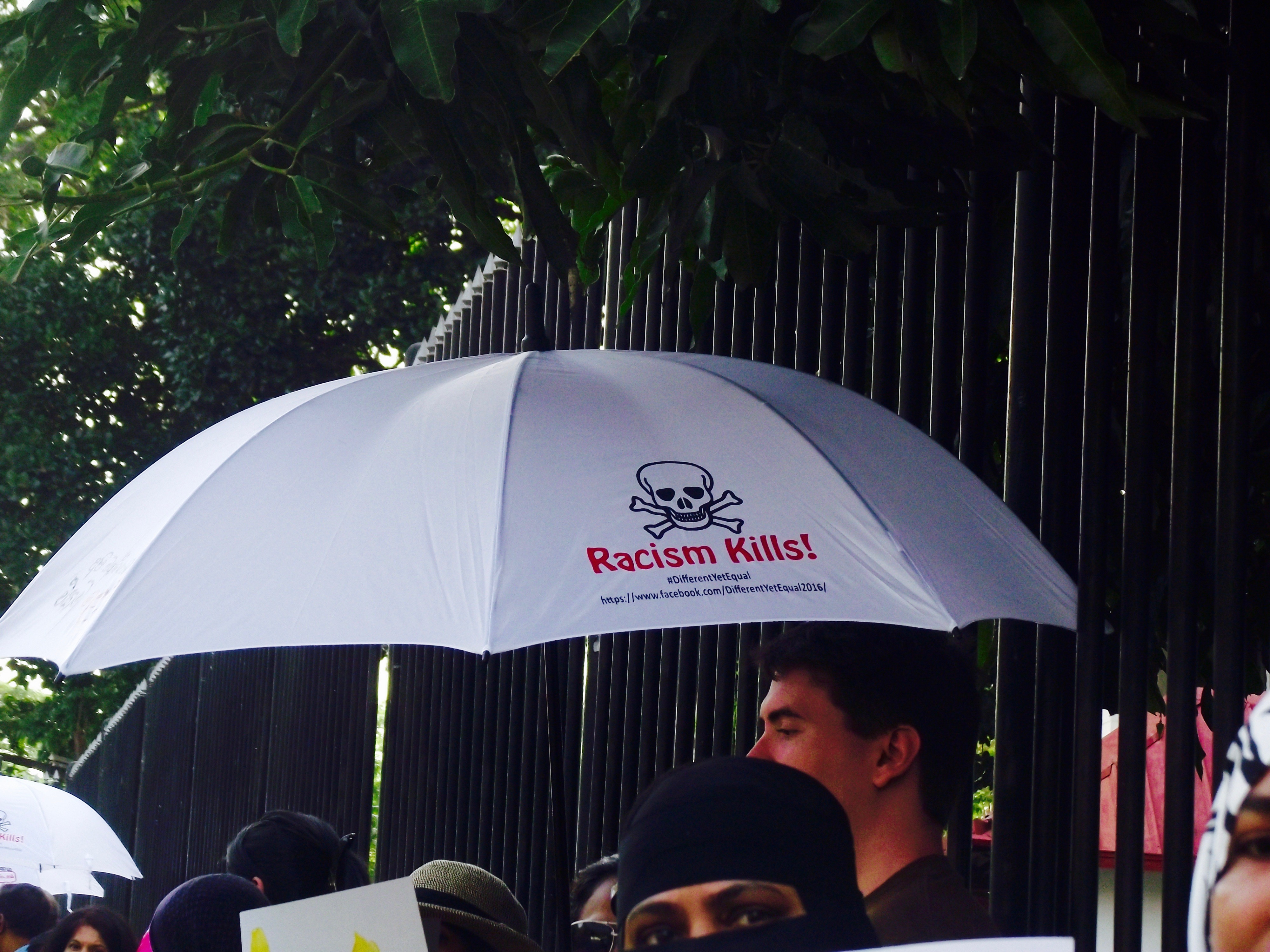The corner of Bauddhaloka mawatha near Independence Arcade was relatively quiet at 4:30 pm, apart from a small group holding white umbrellas.
These were participants of “Different Yet Equal” an online-led campaign aiming to hold a peaceful vigil to advocate for a pluralist Sri Lanka, united against hatred and divisiveness.
As the crowd slowly grew, vigil participants eventually lined themselves up along the pavement, holding placards proclaiming “We all have the same blood” and condemning racism.
The underlying message was pushback against the distinctive stickers which now adorn many trishaws and vehicles across the country – all bearing the word “Sinha-Le”. While there has been no violence as yet from this group, Muslim houses were spray-painted with this slogan earlier this year.
As vigil-goers began to speak about why they had gathered, a sudden disruption occurred, when a group of counter-protesters, including Buddhist monks, gathered, purporting to be from the Sinha Le movement. The monks said they objected to the appropriation of the term “Sinha Le”, which they felt was ‘their’ word. “This is a Sinhala Buddhist country” was chanted repeatedly. The group was also carrying a distorted version of the Sri Lankan flag, notably missing the stripes denoting the minorities.
Initially, tensions ran high, with some of the participants, including former Deputy Mayor of Colombo Azath Salley, attempting to take on some of the counter-protesters verbally. The situation escalated into a shouting match.
Video footage of the argument between vigil participants and the pro Sinha-Le faction
It was telling that most of the counter-protesters brought up Sri Lanka’s population and the fear that the Sinhala Buddhist population was, somehow, being overrun by minority communities. Upon being asked to leave, they refused saying, “Let them leave! This is our country!”
Police inaction
As the chaos in the video unfolded above – the police had to be prodded into action. Though there was a policeman standing just feet away, directing traffic, the participants in the vigil had to request him to intervene in the unfolding situation. Even then, their priorities appeared to be to ensure that traffic remain unobstructed. While this is indeed important, no attention was given to the group flying the distorted Sri Lankan flag.
When vigil participants pointed out that the flag was distorted and asked if this was the true national flag, the Sinhale faction sneered, “Yes, check your history books.”
However, Article 6 of Sri Lanka’s constitution clearly depicts the national flag, making this distortion an offence. Yet the police made no move to make any arrests, even when this was pointed out to them by the crowd.
Eventually, the police made an attempt to alleviate tensions by asking the participants to sit down on the pavement and stop disrupting traffic. This the participants promptly did. However, the group of counter-protesters continued trying to agitate the crowd- and it was only then that one of the police officers pushed him away from the scene. The group stubbornly remained until the vigil ended.
Yesterday’s vigil highlighted that the insecurity felt by some Sinhala Buddhists continues to persist, despite the fact that they remain the majority community. It was equally clear, however, that the disruption was both organised and deliberate – and sadly, it worked, to some extent. The media turned instantly to the clashes and the raised voices, and away from the participants who were peacefully holding signboards. They captured the ugly statements – the continued insistence “This is a Sinhala Buddhist country.” It was this message – one of hatred and divisiveness spouted from the mouths of a few – that was also communicated in reportage of the event.
This is something that should perhaps have been foreseen and better prepared for, given that a candlelight vigil organised in front of the Buddhist Cultural Centre on Sambuddatva Jayantha Mawatha in 2013, was disrupted in a similar manner, which was also covered extensively by Groundviews.
Responding to the virulent and xenophobic rhetoric being spewed by this small group, some participants could not resist engaging in verbal shouting matches – which seemed to be exactly what the smaller group had bargained for, as it gave them the chance to grab the spotlight. Apart from the appearance of the distinctive ‘Le’ stickers as well as the formation of parties like the Sinhale Jathika Balamuluwa, these hardline extremists had been relatively silent until yesterday. It was clear, therefore, that their presence at the Different Yet Equal vigil was a blatant attempt to generate publicity towards their own cause.
It was only when some of the more canny participants asked the others to sit down on the pavement and continue peacefully with the vigil, that the wind was taken out of the counter-faction’s sails.
This is not to say that there were not some high points – as the pro Sinhale faction continued to spew venom, the participants decided to sing “Lowe Sama” to drown them out:
#differentyetequal participants attempting to drown counter voices with song #lka #SriLanka pic.twitter.com/X0yffzKIcW
— Groundviews (@groundviews) August 15, 2016
This proved far more effective than raised voices – the opposing faction now looked nonplussed, and for the time being, stopped their chanting.
It is a shame, however, that an event with a largely positive message was disrupted with hatred and divisiveness, allowing for a small group of extremists to grab the spotlight, even if only briefly.
Below are audio clips from those who attended the vigil, on why they decided to do so:
In reflecting on the events of August 15, the words of Tissaranee Gunasekara come to mind,
“[Sinha Le] needs to be countered… We have a battle to wage, but it must be waged in the terrain of ideas. We must meet their insanity with logic, their ravings with facts, their incitement to violence with appeals to reason. This is also a struggle which moderates of other ethnic and religious communities must wage against their own extremists. Not doing so would be a deadly mistake.”
[Readers who found this article illuminating should read Tissaranee Gunasekara’s article “Sinha Le Politics and Socio Cultural Persecution” and Lukman Harees’ article on the need for inclusive reconciliation].



